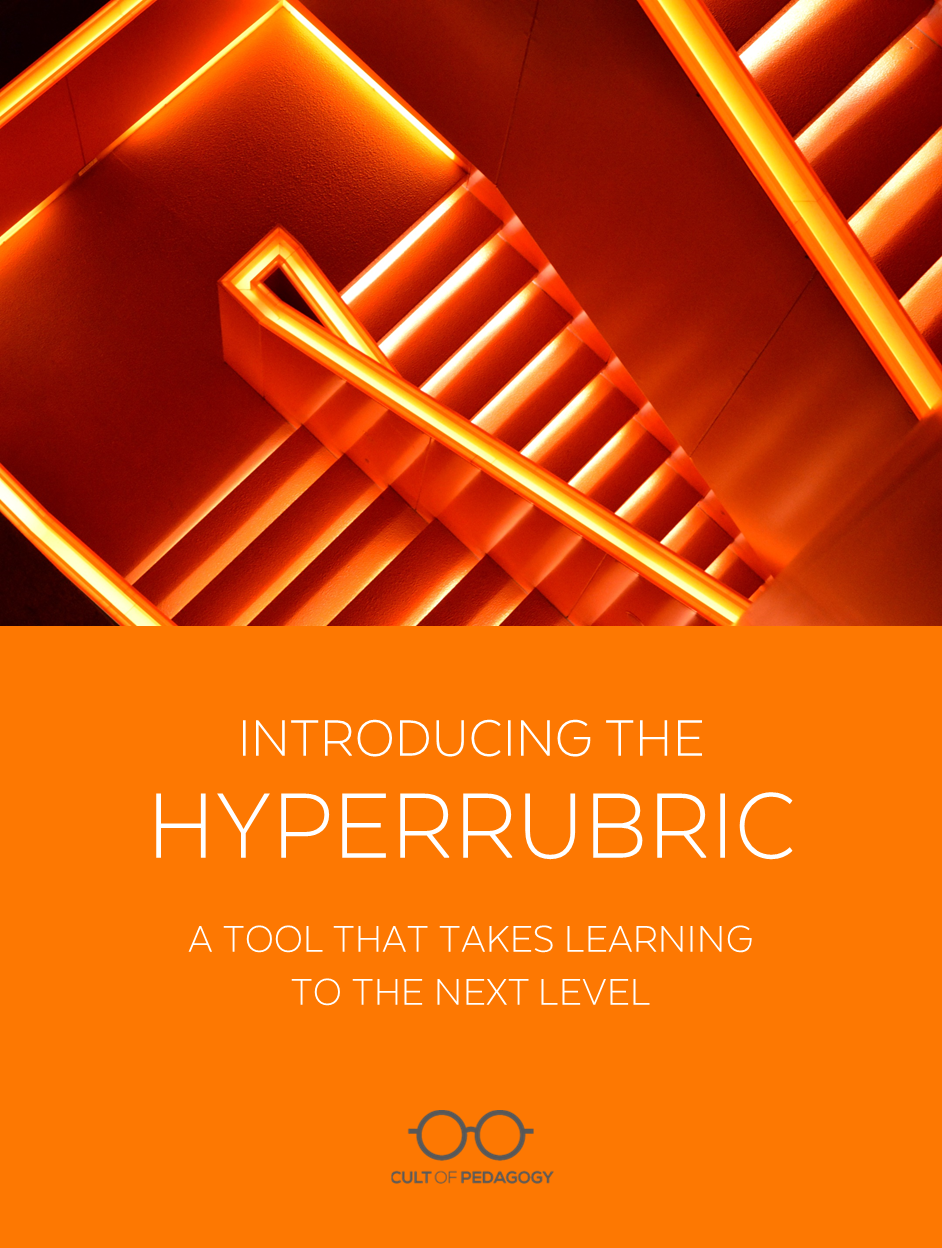
Listen to the interview with Tyler Rablin and Jeffery Frieden (transcript):
Sponsored by Listenwise and ISTE
I’ve always believed in the power of a good, clear rubric for helping students understand how their work will be assessed. As an English teacher, I can’t even imagine assigning a writing task without a rubric. But all rubrics are not the same: Some can be convoluted messes that overwhelm students, while others can be far too vague to really be helpful. Ideally, all teachers would use the most effective rubrics all the time, but we’re not quite there yet.
On this site, we’ve explored lots of rubric tweaks and iterations that make them more effective, and this post will add more to that work: A different way of developing and using a rubric that changes it from a tool for evaluation to a tool for marking progress and pushing students to keep moving forward.
Two English language arts teachers—Tyler Rablin and Jeff Frieden—developed this idea (first Tyler, then Jeff) and are calling it a HyperRubric. On the podcast we talked about how this style of rubric came to be and how it works. The full transcript is available above. What follows here is a summary of our conversation.


Part 1: Hitting Walls with the Traditional Rubric
This story starts with Tyler Rablin, a high school English teacher from Sunnyside, Washington. After working for several years with the traditional four-column rubric, Rablin found himself wanting more. “I know rubrics are important, I know there’s value in them, but I’m not seeing them really impact my students in a way that I would like to see.”
He identified two main issues with the traditional rubric:
- Finality
The four-column rubrics Rablin was using did nothing more than describe student skill levels, and they did so in a way that discouraged future growth. “The earlier levels were often stigmatizing,” Rablin says. “It was, These are all the things I can’t do. I’m weak at this. The later levels were the better ones: Good is here and bad is here. When I was giving students that feedback they were not getting the message of, You’re at the beginning stage in this learning process. They were getting the message of, You’re not doing well at this. When you hand that to a student, it just, it crushes them, and there goes motivation almost right away.” - Clarity
“The language was basically like, I kind of get it, I sort of get it, I mostly get it,” Rablin says. “And for the student, what does that mean? Where do I go next?” For a student who doesn’t really understand the concept, “they don’t have a way into that learning. They don’t really know where to start.”
He started to envision a different kind of rubric, one that would actually help students make progress. It would spell out what they could already do in concrete terms, then show them the skills they needed to develop to move forward.
Part 2: Imagining a More Progressive Rubric
Rablin began experimenting with a new approach: replacing the static descriptors in his rubrics with language that was progressive. He referred to this style of rubric as a Learning Progression.
The image below shows the difference. To keep things simple, this example just focuses on a single row in a rubric containing criteria for using commas with coordinating conjunctions.
In the top rubric—done in a traditional style—the criteria vaguely labels the student’s skills in terms of how many mistakes they make. It doesn’t give them any information about what skills to develop and how to get better.
In the bottom rubric—done as a Learning Progression—the criteria is couched in terms of concrete things a student can learn to do, things that will help them improve.
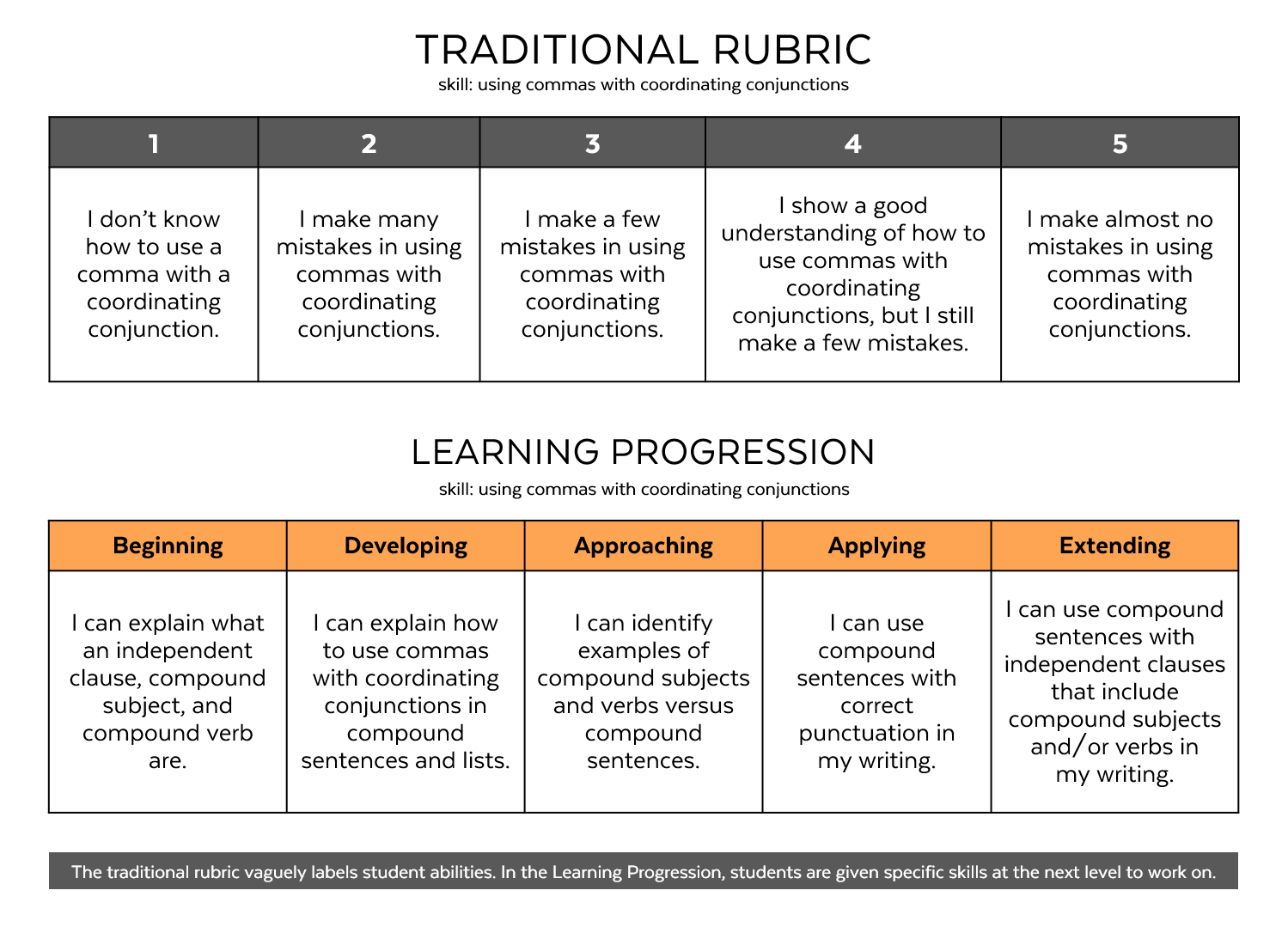
In this example, and in many of Rablin’s other rubrics, those concrete demonstrations start at the lower levels of Bloom’s, where students are simply defining and identifying, and move up to higher-level tasks where they apply, evaluate, and create with the target skill.
Part 3: Making the Rubric “Come Alive”
If the rubric is digital, teachers can also add an additional layer that hyperlinks the skills in the rubric to resources that teach the skill, thus enabling students to start making progress right away.
With the addition of these hyperlinks, the rubric now becomes a HyperRubric.
See the difference in the examples below, which assess students’ skills in analyzing character development in a text. The top rubric is traditional, with vague descriptors of the skill at different levels. The bottom version, a HyperRubric, not only offers more concrete sub-skills students can work to develop, but also contains links to videos, articles, and models that teach the student how to apply those sub-skills.
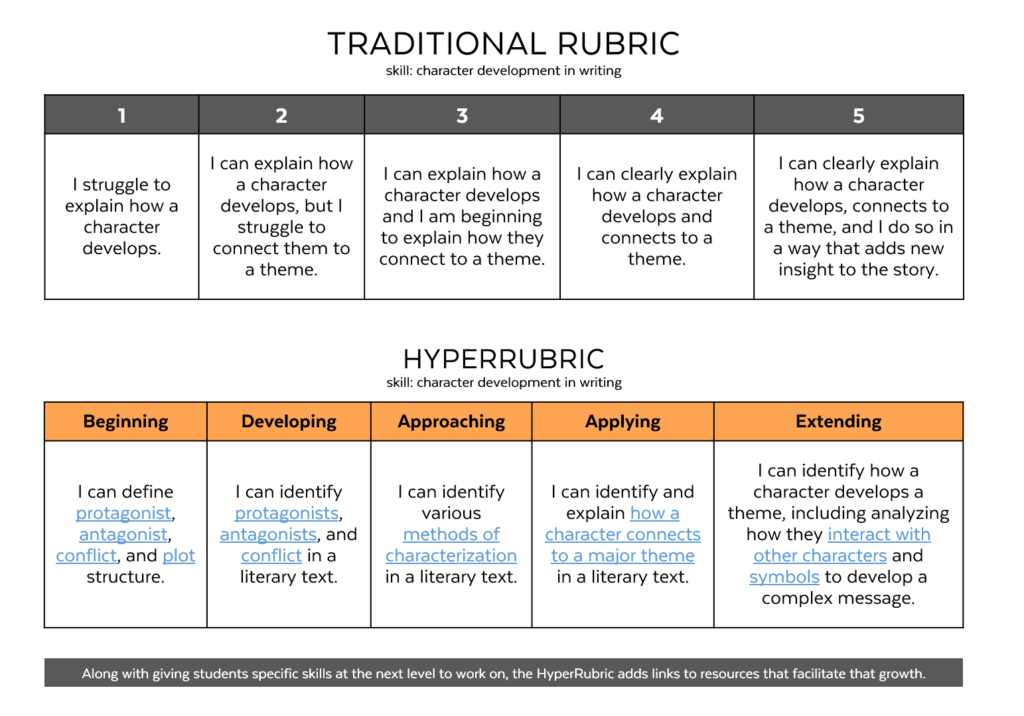
Part 4: Putting the Rubric to Work in a Real Classroom
Now that we’re clear on what a HyperRubric is, it’s probably obvious how much more useful it could be than a traditional rubric. Still, if we’re only using it at the end of a learning cycle, as a tool to evaluate work that is already done, its value will still be limited.
Ideally, a HyperRubric will be used within a cycle of feedback, reflection, and iteration, where students can use it to actively work on their skill development.
One example of this is how Jeff Frieden uses it.
Frieden, a high school ELA teacher in southern California (and the person who brought us the ongoing conversations strategy in 2018), first heard Tyler Rablin talk about his new approach to rubrics on an episode of the Teachers on Fire podcast. As he listened, he realized that this different kind of rubric would be perfect for the shift he’d been trying to make with his writing instruction, a shift that moved assessment from the end of a writing piece to the middle.
“For 13 years, I had been assessing the final product,” Frieden explains. “I had a (traditional) rubric and it tended to come at the end. So it was really just an impact on the grade. And full confession, I was using it to justify the scores I was putting on the papers. The hope was that it would transfer to their next piece of writing. But that’s not really what happened. Maybe occasionally it would for a few students, but for the most part it was just me sort of covering myself just to make sure that everybody could understand why points were missing from the document.”
Recently he shifted his approach, giving students a prompt for a writing task, having them do a first draft quickly, then planning his teaching around the areas of need he identified in the first drafts.
The new process, when face-to-face instruction was still the norm, looked something like this:
- Students write first draft, then teacher assesses drafts to reveal trends in writing for whole-class feedback/instruction.
- Students write second draft after receiving targeted mini-lessons in small groups through station rotation.
- Students write third draft, followed by quality check through station rotations.
- Submission and evaluation.
Pre-pandemic, this system worked well, but once students and teachers moved into remote teaching, station rotation became much harder to do. Frieden knew he’d need a vehicle that would enable students to self-assess, along with resources that could help them teach themselves the skills they’d need to progress.
In the midst of this, Frieden saw Rablin’s rubric and knew he’d found the answer. Now his writing cycle follows a similar pattern to the one he was already working on, with the HyperRubric now taking the place of the targeted mini-lessons:
1. Students Write First Draft
Based on a prompt, students write a relatively quick first draft with very little instructional support from the teacher. From there, Frieden reviews the drafts for trends.
2. Teacher Builds HyperRubric
Frieden now builds a HyperRubric based on the trends he saw in the first draft, areas for growth that are common to many students. “At the maximum I would do three of these,” he says. “If I really want this learning to stick, if I really want them to see it’s valuable, then I will reduce it to the really high leverage items.”
Within each cell of the HyperRubric, he links to mini-lessons that will help students reach that specific level.
3. Students Self-Assess and Write Second Draft
From there, students self-assess their work using the HyperRubric, clicking on links to the mini-lessons, and revising. “Right as they’re learning the lesson,” Frieden says, “it’s impacting their draft as soon as they get it.”
Here’s an example of a HyperRubric for persuasive writing, where the focus is on organization. The student has identified their current level, has completed the mini-lesson on transitions at the next level, and has written a reflection about this process:
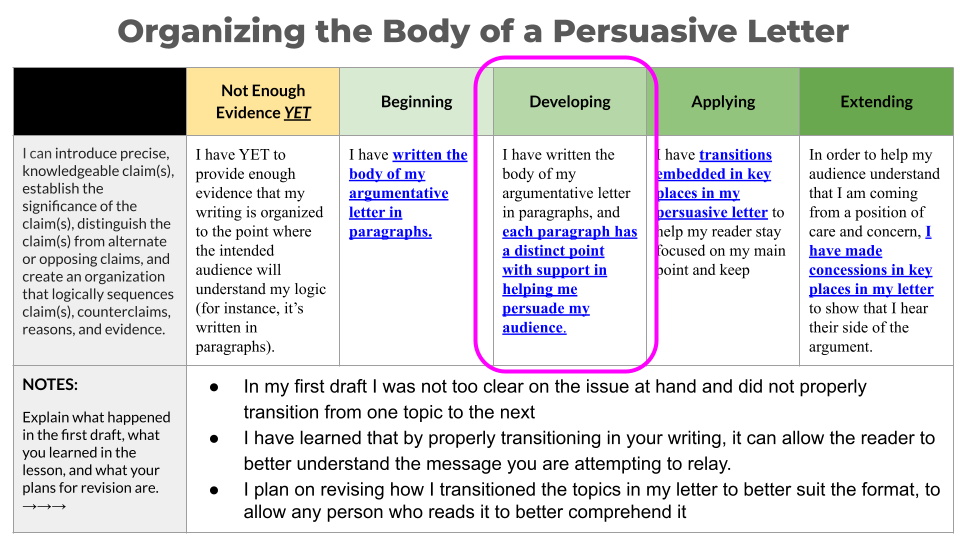
Once the second draft is written, Frieden’s students write another reflection on the changes made to their draft:
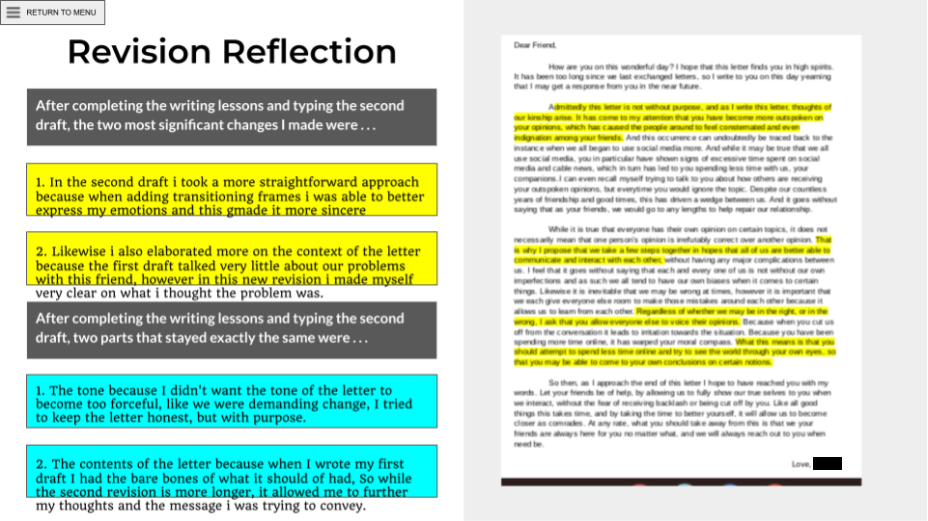
From there the cycle can continue with more self-assessment, reflection, and revision until the piece is ready to be submitted.
Other Questions About HyperRubrics
We’re looking at examples of single skills on a rubric, but teachers are expected to teach many different standards. How does that work?
At Rablin’s school, where they operate on the trimester system, he has recently begun focusing on about eight progressions per trimester, eight skill areas that he targets through various assignments over the course of the term.
“It was kind of a shift for me,” he says, “because at first, that didn’t sound like a lot. I’m used to if it’s just I can analyze theme in a text, that feels like one thing that we’re learning. But when I broaden it out and thought about it in terms of learning progressions, I had to recognize that every single thing I was doing, students were learning five separate skills. Does that mean this is all we’re learning? Absolutely not, but in terms of the progressions I’m being really intentional with, I had to learn to limit it to a lot more than I was used to.”
Frieden limits his use of the HyperRubric to certain types of assignments. “If you’re a teacher listening to this and you’re thinking, oh, that sounds like I have to set up an entire trimester geared towards that and I’m not ready for that. I’m actually using the HyperRubric as one point in a particular type of assignment.”
What about grades? If these are meant to be progressive, how and when do you actually assign students a grade?
Rablin bases a lot of his grades on conferences with students. “Our conversations are centered around these learning progressions. There is an average of scores that results in their final grade. But I’m not averaging those scores over time. It’s not necessarily that I’m counting your earliest attempts and your latest attempts (equally). We had eight skills; overall, what was your final performance or what was your most consistent performance with those eight skills? Your most consistent or more recent scores are what are going to determine your final grade for the course.”
When he calculates grades with HyperRubrics, Frieden gives the most weight to student reflection. “The standard is the focus, and it’s trying to move them along on this progression. But I’m very, very much going to be asking students when it comes to their letter grade, can you articulate to me how this learning that you had in the middle of this assignment impacted the second draft? And then that’s where I’m going to focus all of our energy and importance and I guess the worth of the grade.”
To learn more about how Rablin and Frieden use HyperRubrics, you can find them on Twitter at @Mr_Rablin and @SurthrivEDU.
Join our mailing list and get weekly tips, tools, and inspiration that will make your teaching more effective and fun. You’ll get access to our members-only library of free downloads, including 20 Ways to Cut Your Grading Time in Half, the e-booklet that has helped thousands of teachers save time on grading. Over 50,000 teachers have already joined—come on in.


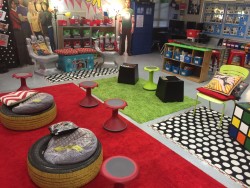


This is genius! In my state (Idaho), we never closed down and I love the rotating stations idea! I would also post these rubrics, complete with hyperlinks, on Google Classroom. Thanks!
On another topic, now that many people
are back in the classroom, teachers are going all out on classroom setup. How about another episode of “Classroom Eye Candy”?
I have definitely been thinking about it, Debbie!! 🙂
Does anyone know if we can add links to rubrics on Canvas? My district is using canvas instead of Google Classroom.
Hi, Claudia! I don’t think that Canvas currently supports hyperlinks directly in their rubric tool. However, I’m hopeful that other readers will have some ideas they can share for how to utilize HyperRubrics within the Canvas LMS!
You can’t directly on Canvas, but you can link your Google Docs to Canvas and have the students download a rubric from there, with hyperlinks in that doc.
I checked with our ETS when I read this post. Apparently, one cannot add hyper links in Canvas. I was pretty sad to hear that.
This idea is very similar to innovation configuration maps, which emanated for the concerns-based adoption model from the southeast development lab in the 1970s. IC maps are very specific about what is being done (not what is not being done or using vague descriptors (“some”) to assess). IC maps also don’t use a specific number of columns to hem in the creator. However many variations of the ideal behavior…that is how many columns you need! IC maps has been a game changer in my work when rubrics have been too frustrating or complex to create.
Thomas, I looked up the IC maps, and yes this is similar. The examples I was looking were full of deficit language at the earlier levels. Is that how all IC Maps work?
I just adopted this model of creating rubrics, but used our school’s IXL skills program. Instead of web links, I choose and insert IXL’s skills codes. Benefit? I can track whether the student has accessed those skills, even watch in real time as they practice.
Thanks for sharing!
I love the idea of using IXL skill codes for 1st graders. Wow! What a lovely way of instilling the practice?
I love this so much! I feel like the trend is to over-scaffold before students can try their hands at things. Having students write their best first draft without a rubric gives them a chance to practice what they might have internalized, making them more independent.
I hope you can respond to a clarification question. Rablin said: “I’m used to if it’s just I can analyze theme in a text, that feels like one thing that we’re learning. But when I broaden it out and thought about it in terms of learning progressions, I had to recognize that every single thing I was doing, students were learning five separate skills.” Did he mean that every assignment has the same five skills, or that each one skill tends to have five things embedded in it? If it’s the former, can you clarify which skills you mean?
Thanks again for sharing this. I can’t wait to try it!
Hi Jessica,
I think he means that within a progression there are about 5 different skills kids need to “progress” through and understand in order to get to the target. In the podcast episode, he mentions that it’s not just that kids can analyze a theme, but in order to do that, some kids might need to learn progress through some other things, such as first understanding conflict. So, whatever standard you’re teaching, it is going to have its own progression of skills. Take another look at some of the samples in the post – I think that will help clarify your question. Thanks for asking!
This seems like an incredible idea and I’m really excited to try it out this year. It seems like a lot of work to set up the hyper rubrics with all the links to specific lessons, etc., and it seems like it needs to be done fairly quickly to get students from the first to second draft. The example one looks great, but there’s only one example. Are there any other resources anyone has created they’d be willing to share?
How can you use a hyper rubric when it comes to an annotation for a Novel or a mini project with the novel? Do you hand out the rubrics each time and have students assess themselves and then collect the rubric and evaluate?
I almost gave up HyperRubric with my 6th graders because I felt incompetent to carry out such an enormous task. Thank you, Jeff Frieden, (@SurthrivEDU), for encouraging me with quick responses and Loom video explanations.
This post is a bit long, but I want to explain the rollercoaster of trials and errors that led me to the final touchdown.
The Huddles
I wanted to make a HyperRubric for narrative writing. My enthusiasm was high, but the lack of experience quickly smothered it.
Here are some emails that I sent Jeff.
There is a Korean idiom that encapsulates how I feel right now.
“A pigeon that imitates a stork will get its legs torn apart.”
OMG
This is hard. I don’t know what to do for the last two lessons.
The biggest challenge was making lessons that would help students move forward along the learning continuum. The lessons needed to be:
Concise
Informative
Engaging
Relevant
I surfed the web for premade videos, but I knew that I had to make the videos myself. But then, how could I reteach narrative writing in four short videos?
I put a pause on Narrative Writing HyperRubric and dabbled with Compound Sentences HyperRubric. The lessons, I thought, would be easier to conceptualize since they focus on specific skills.
It was not as easy as I thought.
I had six different versions of HyperRubric at varying degrees of completion.
More sleepless nights.
The Touchdown
Then, I assigned an argumentative essay to my students. When they were working on their first draft, I noticed different levels of common misconception in their essays.
Lessons that seem so difficult to grasp materialize right in front of me.
I reopened the HyperRubric, modified it a bit to meet the needs of my 6th graders, made Edpuzzle videos, and posted it on Google Classroom.
I cannot tell you how exhilarating it was to see EVERYONE on task, targeting different lessons, going back to their drafts, and making revisions. Because I was untethered from my desk, I walked around and held mini writing conferences.
It was a dream come true.
Here is a Loom video that I sent to Jeff, celebrating my students’ success.
https://www.loom.com/share/cca835077c754e78b1db61feeaebb8f9
After just one HyperRubric, my 6th graders are using terms like feedback, revision, and improvement when speaking about their writing.
Mina, thank you for taking the time to share your experiences with HyperRubrics! Jenn will be thrilled to hear how well this has worked for you and your students. I’ll make sure she sees this!
Is it fair to describe this approach as “scaffolding made explicit and accessible to learners”? I really like how it takes a very proactive and formative stance, instead of a merely evaluative one.
Thanks for another gem!
I am a math teacher and I am going to try to develop a hyperrubric for some of the ‘long processes’ (graphing transformations of functions, solving equations). Always looking for any suggestions / sharing from anyone who has started the process in a math setting.
I want to see this when you have a prototype! email me at surthrivedu@gmail.com
Did you manage to create a hyperrubric for maths? We are just starting to look into this now
These remind me of NWEA’s Learning Continuums as well as the teacher and principal evaluation instruments used throughout the state of North Carolina.
Here is an article on the topic from the ASCD:
https://www.ascd.org/el/articles/the-lowdown-on-learning-progressions
Here is a link to a site that provides very basic learning progression maps that you can use as a springboard for your rubric(s):
https://blog.centerpointeducation.org/blog/how-to-use-progression-maps
This site has lots more resources for developing learning progression maps/rubrics:
https://www.karin-hess.com/learning-progressions
Thanks for sharing these resources, Hope!
Now how could you use this in social Studies?
Ashley, the HyperRubric could be used to assess students’ understanding of content as well as skills in any discipline. In Social Studies, for example, if you’re teaching geography and map-reading skills, you could develop a skills progression rubric that starts with identifying cardinal directions using a compass rose, moving towards pinpointing locations on a map using longitudinal and latitudinal coordinates, comparing and contrasting types of maps, explaining the significance of maps, and so on, with increasingly complex skills based on your state’s standards. I usually develop a few rubrics for each unit of study that guide my teaching and help my students keep track of what they’ve learned and what they will be expected to learn next. In general, I think you’ll find that once you have the content standards in front of you, or even old rubrics, you will get comfortable with the new format relatively quickly. Best of luck!
Does the mini lesson have to be an edpuzzle or can it simply be one on one with teacher notes and student reflections?
Has anyone mentioned here read “Assessment for Teaching” (ed, Patrick Griffin) particularly the use of pairwise analysis?
Hi Anna,
Great recommendation! I took a look at the book and it seems like it would pair well with this article in terms of how the author talks about the promotion of growth along a developmental continuum. I believe these forms of assessment help students take ownership of their learning and make their next steps clear and predictable. Thanks for this!